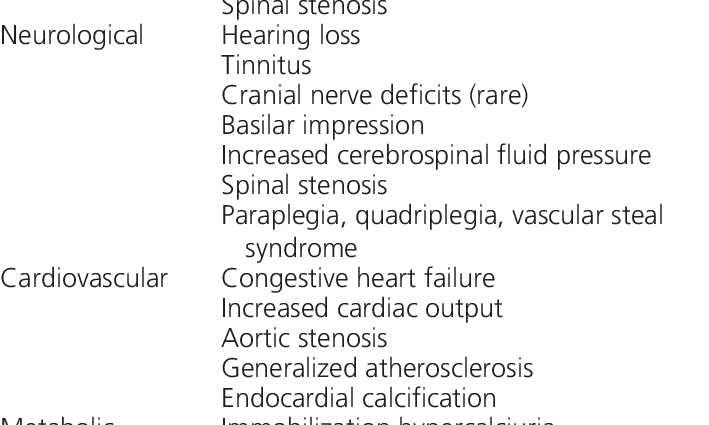Symptoms of Paget’s disease
Paget’s disease can affect one or more bones. It only affects bones initially affected (no extension possible on other bones).
It is most often asymptomatic, discovered by chance during radiographic examinations carried out for another reason.
Several clinical signs can reveal the disease and justify the prescription of radiological examinations:
—bone pain
—bone deformities : they are inconstant and late (sign of the hat by hypertrophy [increase in volume] of the skull, saber-blade tibia, flattening of the thorax, deformation of the spine [kyphosis])
—troubles vasomoteurs (blood vessel abnormalities) responsible for hyperemia (excessive influx of blood causing redness) of the skin next to bone lesions
Note that there is no deterioration in the general condition.
The bones most affected by the disease are the bones of the pelvis, the dorsal and lumbar vertebrae, the sacrum, the femur, the skull, the tibia.
The x-rays make it possible to highlight characteristic signs of the disease:
– abnormalities of shape: bone hypertrophy (increase in volume)
– structural abnormalities: thickening of the corticals (bone walls)
-density anomalies: heterogeneous condensation of the bone giving a padded appearance
Bone scintigraphy can highlight intense hyperfixation on the affected bones. The main interest of this examination is to identify the bones affected by the disease. However, there is no need to repeat it during the monitoring and treatment of the patient.
The increase in alkaline phosphates in the blood is proportional to the extent and activity of the disease. It reflects the intense activity of bone formation. This dosage may be normal if the disease is localized to a single bone.
The dosages of crosslaps (also called CTx or NTx) and pyridinolines in the blood or urine are increased and testify to the activity of bone destruction.
Unlike a bone scan, these scans are useful for monitoring disease under treatment. As such, they are performed every 3 to 6 months.
To note that :
-calcemia (calcium level in the blood) is usually normal. It can be increased in the event of prolonged immobilization or associated hyperparathyroidism.
-the sedimentation rate is also normal.
The complications of the disease are variable from one patient to another and are of the following order:
—articular : mainly affecting the hip and knee, they are linked to deformities of the ends of the bones caused by the disease and are responsible for pain, deformation and functional impotence
—bone : fractures are caused by weak bones
More rarely, complications can arise:
—nerve : related to the compression of nerves by the deformation of the bones. Thus, it is possible to observe deafness most often bilateral (affecting both ears), paraplegia (which can be treated)
—heart : heart failure
Exceptionally, the occurrence of a malignant tumor can occur on the bone affected by the disease (humerus and femur). An increase in pain and radiographic abnormalities may suggest this diagnosis, which can only be confirmed with certainty by performing a biopsy.
Paget’s disease should not be confused with:
– hyperparathyroidism
-bone metastases from breast cancer or prostate cancer
– multiple myeloma (also called Kahler’s disease)










